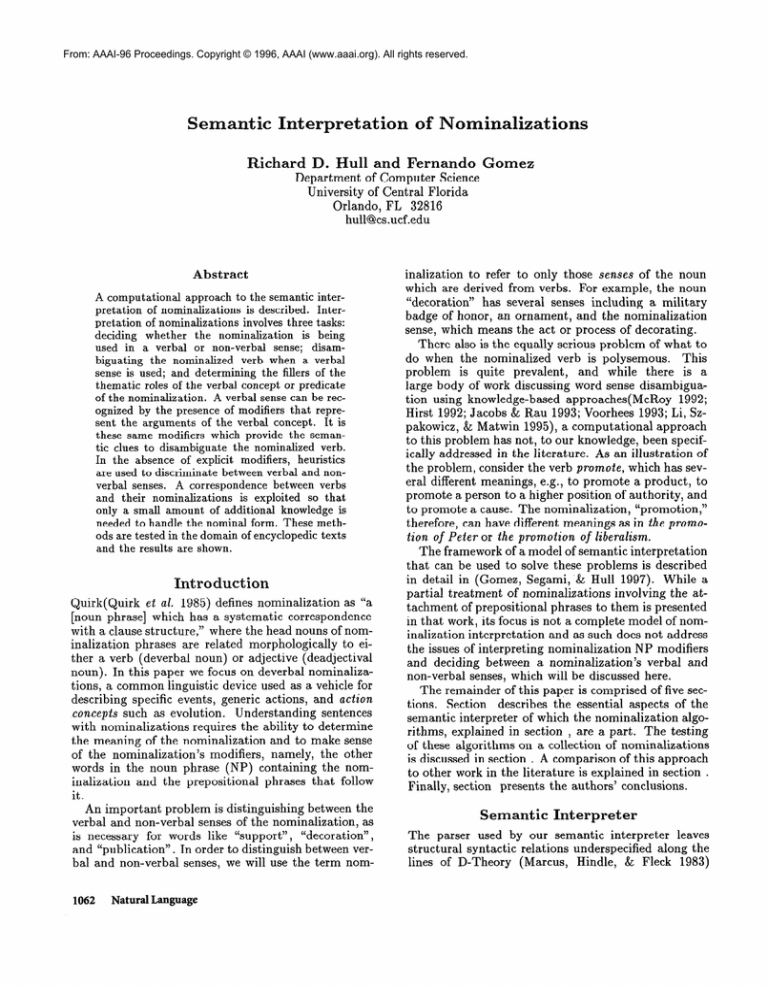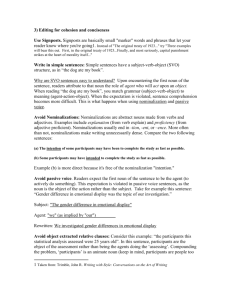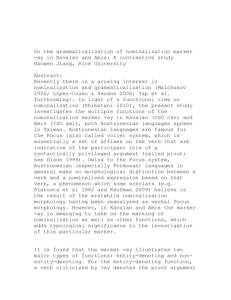
From: AAAI-96 Proceedings. Copyright © 1996, AAAI (www.aaai.org). All rights reserved.
Semantic
Interpret at ion of Nominahat
Richard
D. Hull and Fernando
ions
Gomez
Department of Computer Science
University of Central Florida
Orlando, FL 32816
hull@cs.ucf.edu
Abstract
A computational
approach to the semantic interpretation
of nominalizations
is described.
Interpretation of nominalizations
involves three tasks:
deciding
whether
the nominalization
is being
used in a verbal or non-verbal
sense;
disambiguating
the nominalized
verb when a verbal
sense is used; and determining
the fillers of the
thematic roles of the verbal concept or predicate
of the nominalization.
A verbal sense can be recognized by the presence of modifiers that represent the arguments
of the verbal concept.
It is
these same modifiers which provide the semantic clues to disambiguate
the nominalized
verb.
In the absence of explicit modifiers,
heuristics
are used to discriminate
between verbal and nonverbal senses.
A correspondence
between verbs
and their nominalizations
is exploited
so that
only a small amount of additional
knowledge is
needed to handle the nominal form. These methods are tested in the domain of encyclopedic
texts
and the results are shown.
Introduction
Quirk(Quirk et al. 1985) defines nominalization as “a
[noun phrase] which has a systematic correspondence
with a clause structure,” where the head nouns of nominalization phrases are related morphologically to either a verb (deverbal noun) or adjective (deadjectival
noun). In this paper we focus on deverbal nominalizations, a common linguistic device used as a vehicle for
describing specific events, generic actions, and action
concepts such as evolution. Understanding sentences
with nominalizations requires the ability to determine
the meaning of the nominalization and to make sense
of the nominalization’s modifiers, namely, the other
words in the noun phrase (NP) containing the nominalization and the prepositional phrases that follow
it.
An important
problem
is distinguishing
between the
verbal and non-verbal senses of the nominalization, as
is necessary for words like “support”, “decoration”,
and “publication”. In order to distinguish between verbal and non-verbal senses, we will use the term nom1062
Natural Language
inalization to refer to only those senses of the noun
which are derived from verbs. For example, the noun
“decoration” has several senses including a military
badge of honor, an ornament, and the nominalization
sense, which means the act or process of decorating.
There also is the equally serious problem of what to
do when the nominalized verb is polysemous.
This
problem is quite prevalent, and while there is a
large body of work discussing word sense disambiguation using knowledge-based approaches(McRoy 1992;
Hirst 1992; Jacobs & Rau 1993; Voorhees 1993; Li, Szpakowicz, & Matwin 1995), a computational approach
to this problem has not, to our knowledge, been specifically addressed in the literature. As an illustration of
the problem, consider the verb promote, which has several different meanings, e.g., to promote a product, to
promote a person to a higher position of authority, and
to promote a cause. The nominalization, “promotion,”
therefore, can have different meanings as in the promotion of Peter or the promotion of liberalism.
The framework of a model of semantic interpretation
that can be used to solve these problems is described
in detail in (Gomez, Segami, & Hull 1997). While a
partial treatment of nominalizations involving the attachment of prepositional phrases to them is presented
in that work, its focus is not a complete model of nominalization interpretation and as such does not address
the issues of interpreting nominalization NP modifiers
and deciding between a nominalization’s verbal and
non-verbal senses, which will be discussed here.
The remainder of this paper is comprised of five sections. Section describes the essential aspects of the
semantic interpreter of which the nominalization algorithms, explained in section , are a part. The testing
of these algorithms on a collection of nominalizations
is discussed in section . A comparison of this approach
to other work in the literature is explained in section .
Finally, section presents the authors’ conclusions.
Semantic
Interpreter
The parser used by our semantic interpreter leaves
structural syntactic relations underspecified along the
lines of D-Theory (Marcus, Hindle, & Fleck 1983)
and minimal commitment parsers (Weinberg 1993).
The parser recognizes the following syntactic relations:
subject, object 1, object2, predicate, and prepositional
phrases (PPs). Object1 is built for the first postverbal
noun phrases (NPs) of transitive verbs, and object2 for
the second postverbal NP of diatransitive verbs. The
parser also recognizes temporal adjuncts of the verb;
but, as indicated, it does not resolve structural ambiguity. PPs are left unattached in the structure built
by the parser until the semantic interpreter finds their
meaning and attaches them. As each syntactic relation
is identified, it is passed to the semantic interpreter to
make semantic sense of it.
All important semantic decisions are delayed until
the meaning of the verb is determined. Determining
verb meaning is done by rules that use the types of
syntactic relations built by the parser and the semantic
categories of the nouns in them. For instance, what
determines the meaning of “drive” in (1) is the direct
object of the verb and the fact that “bus” is a motorvehicle (here “drive” means to operate a vehicle), and
that “nail” is a device (here “drive” means to hummer).
(1) Peter
drove the bus/the
nail.
In addition to NP complement rules, prepositional
phrase rules (PP rules) are also used to determine the
meaning of the verb. In (2), the meaning of “left” is
identified by two for-rules stored in its lexical entry:
the meaning of “left” is identified its transfer of possession in the first case because the object of the PP
is a human and as depart in in the second because the
object of the PP is a location.
(2)
Jennifer
home.
left th e orange
groves for her son/for
Once the meaning of the verb is established, additional knowledge is needed to interpret subsequent syntactic relations and those which have been parsed but
have remained uninterpreted. This knowledge is stored
in the representation of the verbal concept or predicate. Below are examples of NP complement rules and
preposition rules for the verb “defend”:
(defend
((object
((if% is-a obj location)
(verbal-concept-is defend-physical-thing))
((if% is-a obj idea)
(verbal-concept-is defend-idea)))
(Prep
(in ((if% equal obj-of-prep court)
(verbal-concept-is legal-defend))))
(end-of-clause
((if% is-a obj championship)
(verbal-concept-is defend-championship))
( t (verbal-concept-is defend)))))
The first set of rules selects the verbal concept based
upon the NP complement. If the direct object is a
subconcept or an instance of a location within a hierarchy of concepts, then the meaning of the verb is
defend-physical-thing.
This rule is designed to handle
constructions such as Carleton defended Quebec. If the
direct object is a subconcept or instance of an idea in
the concept hierarchy, then the meaning of the verb
is represented by the verbal concept defend-idea, as in
her defense of the theorem.
If the direct object does
not pass either of these two constraints, then the meaning of the verb is left unspecified in hopes that later
evidence will disambiguate it. The next rule is a preposition rule for PPs that follow the verb “defend” and
begin with the preposition “in”. If the object of such a
prepositional phrase (the object of the PP is the head
of its complement NP) is equal to the word “court”,
then the meaning of the verb is represented by the verbal concept legal-defend.
The last set of rules, called
end-of-clause rules, is used if the parser reaches the
end of a clause and the meaning of the verb is still unknown. If the direct object is a subconcept or instance
of a championship in the concept hierarchy, then the
meaning of the verb is represented by the verbal concept defend-championship.
Otherwise, the meaning of
the verb is the generic defend. These five verbal concepts are displayed below.
(defend
(is-a (action-r))
(subj (agent (actor)))
(obj (thing (theme))
(prep (against (thing (against (strong))))
(from (thing (against (strong))))))
; WordNet sense defend 1.47
(defend-idea
(is-a (defend))
(obj (idea (theme))))
; WordNet sense defend2.5
(defend-physical-thing
(is-a (defend))
(obj (physical-thing
(theme))))
; WordNet sense defend3
(defend-championship
(is-a (defend))
(obj (championship
(theme))))
; WordNet sense defend6
(legal-defend
(is-a (defend))
(obj (agent (theme)))
(prep (in (court (at-hoc (strong))))))
The first entry in the verbal concept defend, @-a
places defend within the hierarchy of action concepts. The next entry is a restriction: if the
subject of defense is subsumed by the agent concept in
the concept hierarchy, then make it fill the actor role.
The other entries represent restrictions on the object
and prepositional phrases. Each of the subconcepts
of defend; defend-idea,
defend-physical-thing,
defendchampionship,
and legal-defend, inherits entries from
(action-r)),
defend.
This fine-grained decomposition of “defend” is necessary if one wishes to make specific inferences depending
on the type of defense. The structures above embody
the knowledge necessary to understand clauses containing the verb “defend” (see (Gomez, Segami, & Hull
1997) for a detailed discussion of VM rules and verbal concepts). This verbal knowledge can be exploited
and reused for interpretation of nominalizations, if a
small amount of additional information detailing how
the nominalization’s modifiers relate to the syntactic
Semantics & Discourse
relations of the VM rules and verbal concepts is constructed. Knowledge indicating whether any thematic
roles are “obligatory,” that is, necessary for a verbal
sense interpretation, is also stored.
The nominalization “defense” is shown below. Defense has one obligatory role, theme. Because “defense” has both verbal and non-verbal senses, a requirement is made that the theme must be present for
a verbal sense to be chosen. A nominalization that
has only verbal senses does not need an obligatory-role
slot. No special mapping rules for genitives or prepositions are present because “defense” behaves like most
nominalizations: genitives represent either the actor or
theme of the action; and besides the preposition “of”
which represents the theme of the transitive verbs and
the actor of intransitive verbs, “defense” inherits the
meanings of its PP modifiers from its root verb, “defend.”
(defense
(obligatory-role
(theme)))
For the majority of nominalizations, no information
over and above that of the verbal knowledge is necessary. However, there are exceptions. Genitive modifiers of the nominalization “attendance” only make
sense as the actors of “attend”. In this case, a slot
specifying that the genitive should fill the actor role is
needed. Another situation where additional information is needed is in the handling of certain prepositional
phrases. The nominalization “control” takes PPs using the preposition “over” as the verb’s object, as in,
his control over the business, while the verb “control”
does not. To handle this, a slot mapping the preposition “over” to the verb’s object is added.
In addition to providing the means for disambiguating between nominal and deverbal senses of the nominalization, verbal knowledge can also be used to disambiguate the underlying verb of the nominalization
when it exhibits polysemy.
It is the prepositional
phrase “in court” that selects the meaning legal-defend
for “defense” in her defense in court, and it is the
prepositional phrase “of Richmond” that selects the
meaning defend-physical-thing
in Lee gave up the defense
of Richmond.
Interpretation
Algorithms
Nominaliaations
Natural Language
Nominalization
for
Noun
Phrase
Algorithm
The nominalization noun phrase algorithm is triggered
when the head noun’ of some NP is determined to
be a potential nominalization. This is accomplished
by consulting WordNet(Miller et al. 1993) to see if
any of the senses of the noun are hypernyms of either
actions or events. Conceptually, the algorithm has two
objectives:
1.
To determine the verbal concept or predicate of the
nominalization, and
2. To identify which thematic roles of the verbal con-
cept, if any, each of the remaining nouns and adjectives of the NP fill.
Determining the verbal concept of the nominalization establishes its meaning within the context of the
sentence. Occasionally, the nominalization has a single
meaning and in those cases we can immediately determine the verbal concept. This trivial disambiguation
is attempted first and works for nominalizations like
“invasion” and “murder .” More often, however, determining the verbal concept requires disambiguating the
nominalization because the root verb of the nominalization is polysemous.
In order to disambiguate polysemous nominalizations, the algorithm uses the root verb to select VM
rules. In addition, mapping rules and heuristics are
needed to handle the fact that nominalizations do not
take bare NPs; the verb’s syntactic subject and object reappear as genitival, adjectival, or prepositional
modifiers. This algorithm addresses genitives, possessive pronouns, single prenominal nouns, i.e., pairs of
the form noun nom, and adjectives which fill thematic
roles. The prepositional attachment and meaning determination algorithm described later handles prepositional modifiers.
Determining
The interpretation algorithms attempt to determine
the verbal concept of the nominalization and to fill its
thematic roles. Determination of the verbal concept
requires disambiguation of the meaning of the nominalization’s root verb. This ambiguity may be resolved
by examining the noun phrase in which the nominalization occurs, or as is true in many cases, disambiguation can only be accomplished by examining postnominal prepositional phrases. Once the verbal concept
has been identified, surrounding nouns are then interpreted as verbal concept arguments. There are three
separate interpretation algorithms: the nominalization
1064
noun phrase algorithm, the prepositional attachment
and meaning determination algorithm, and the end-ofclause algorithm. We will discuss the main points and
then the details of each algorithm in turn.
the Verbal
Concept
The VM rules of the root verb do not include any for
handling genitives, pronouns, or noun/adjective modifiers. Therefore, if these rules are to be reused, some
way of selecting the appropriate ones is needed. The
central problem associated with disambiguation of the
nominalization within the NP then becomes Which
VM rules should be fired? Consider the case where the
NP is of the form: (genitive nominalization).
The genitive may correspond semantically to the verb’s subject
or object, as is illustrated in the examples below.
(3)
Lincoln’s
Lincoln.
election;
The
representatives
‘The algorithm
does not currently
tions in positions other than the head.
handle
elected
nominaliza-
(4)
Metternich
‘s resignation;
Metternich
resigned.
(a)
In (3), the genitive corresponds to the object position, while in (4), it corresponds to the subject position. The verb resign is intransitive, except for colloquial expressions such as “resigned his office”, and
therefore, genitive modifiers of the nominali .zation resignation correspond to the verb’s subject. This idea
forms the first rule selection heuristic. Passive nominals behave differently; their genitive modifiers correspond to the verbal object. A mapping rule selects
the verb’s object rules when the nominalization is passive. If the nominalization’s verb is neither intransitive nor is the nominalization passive, then the genitive could correspond to either the subject or object.
Consequently, the selection of VM rules is postponed,
in hopes that following prepositional phrases will disambiguate the nominalization.
If the nominalization is modified by either a noun or
adjective, it is not possible to determine exactly which
disambiguation rules must be fired. Any ordering of
the rules is guaranteed to be wrong in a large percentage of cases. In addition, it would be unproductive to
try all of the rules in hopes that only the appropriate
one would be triggered. Therefore, disambiguation is
postponed until more ev dence is available in the form
of roles filled by prepositional phrases.
Filling
Thematic
Roles
Once the verbal concept of the nominalization has
been determined, the next step is to determine which
of the other constituents of the NP fill thematic roles of
the verbal concept and what those roles are. A syntactic relation is said to fill a thematic role if the concept
it represents in the concept hierarchy passes the selectional restrictions associated with that role. For example, humans elect humans to institutions as social-roles.
The hierarchy of concepts is consulted to determine if
the argument of the syntactic relation under consideration is-subsumed by the subhierarchy of the selectional
restriction. If it is, then the restriction is passed.
Even when the verbal concept of the nominalization
has been determined, identifying the role that the nominalization’s modifier pl ays is difficult. For this reason
it seems appropriate to wait until all of the roles stemming from prepositional phrases have been identified
before trying to resolve the nominalization’s modifiers
in the NP. That way, candidate roles, if already filled,
can be weeded out. Thus, only the remaining unfilled
roles need to be checked. Below is a detailed descrip-
If the
i.
ii.
iii.
(b)
verbal
concept
If no meaning
Else,
i.
(the
Fire
ii.
If no
rules
Else,
type
If no
exit.
iv.
v.
verbal
a single
sense,
set the
concept
vco
to this
meaning
and
Ifnghas
continue.
2.
If the NP containing
no includes
a genitive
or a possessive
pronoun,
crof” PP, attempt
to realize the qualifier
(or
and there is no modifying
its anaphoric
referent)
as a thematic
role of a verbal concept
from the
nominalization’s
root verb as follows:
concept
nominalization
determined,
then
for the ginitive/pronoun,
has
mapping
not
been
against
the
and subject
goto
step
4.
determined)
rules.
is an -ing
nominalization,
fire the sub-
rules are triggered
and the verb is intransitive,
fire the subject
of the verb.
try both the object
and subject
rules of the verb. If only one
has a rule that fires, take the triggered
verbal concept.
rules are triggered,
the verbal concept
cannot
be determined,
If the NP containing
concept
is unknown,
4.
Else, if the NP containing
verbal concept
is known:
n9 includes
exit.
other
n9 includes
some
qualifier
other
and
the
qualifier(s)
verbal
and
the
If the modifier
is a noun, attempt
to determine
which role the noun
plays in the verbal concept
underlying
the nominalization
as follows:
restrictions
found in the representation
Examine
the selectional
the verbal concept.
If the modifier
satisfies
a single role, make that the interpretation
of the modifier.
Else, procrastinate
until more evidence
is available.
i.
ii.
iii.
of
Else,
if the modifier
is an adjective,
determine
if it can:
fill an
at-time
role, e.g., the 1972 election;
is derived
from a noun which
may fill a role; or is an ordinal
adjective,
in which case,
mark the
adjective
as a temporal
indicator.
Prepositional
Algorithm
Attachment
and Meaning
The prepositional attachment and meaning determination algorithm is activated for each prepositional
phrase found within the scope of some nominalization,
which is defined to be any postnominal position within
the same sentence clause as the nominalization, up to
the main verb (for nominalizations before the verb)
and to the end of the clause (for nominalizations after
the verb). This algorithm has two objectives:
1. To determine if the prepositional phrase attaches to
the nominalization, and
2. To determine the meaning of the prepositional
phrase attachment within the context of the nominalization.
As each such prepositional phrase is parsed from left
to right, the preposition is used to select either VM
rules, if the verbal concept has not been established,
or to select verbal concept selection al restrictions, if it
has been established. If one of these rules fires, indicating that the nominalization takes the preposition, the
PP is attached to the nominalization, and its thematic
role is noted. The prepositional phrase attachment algorithm, shown below, is part of a general semantic
interpretation algorithm that is described in (Gomez,
Segami, & Hull 1997).
Prepositional
1.
was found
3.
(b)
been
Else, if the nominalization
ject rules of the verb.
...
111.
(a)
has
Fire nominalization
mapping
rules.
If no rules are triggered,
check the genitive/pronoun
selectional
restrictions
of the verbal concept’s
object
entries
(subject
entries
only for intransitive
verbs).
Phrase
Attachment
Algorithm
Let n9 be the head noun of some noun phrase
where one or
the senses of n9 represent
a nominalized
verb, and let the verbal
of that verb be VCO. Let ppl,
....
be a list of one or more
tional phrases
that follow no in the sentence.
Applv the algorithm
determine
whether
ppi at‘taches
to (modifies)
&, and whgt the
of
is, that is, its thematic
role:
pp2,
to
1.
pp,
pp;
If the
then
concept,
vc9,
underlying
the nominalization
is not
SemanticsSCDiscourse
more of
concept
preposibelow
meaning
known,
1065
(a)
If the preposition
i.
Use
ii.
(b)
“of”
is “of,”
mapping
If no “of” mapping
nominalized
verb.
Else,
i.
ii.
2.
the
rules
of the nominaliaation,
exist,
(the
preposition
is not
Use the
exist.
appropriate
mapping
Else, attempt
for the given
Else,
rules
if vco
attempt
if any exist.
to fire the obj rules
of the
rrofJ’)
rules
of the
nominalization,
to fire the preposition
preposition.
if any
nominaliaed
is known,
(a)
If the nominalization
has mapping
rules for the preposition,
use
them to select
the appropriate
verbal concept
entry.
If the entry’s
selectional
restriction
is passed,
goto step 3 else goto step 4.
(“1
Else, if the preposition
is “of,” try the obj entries
of UC&-J.
entry’s
selectional
restriction
is passed,
goto step 3 else got0
(c)
Else,
tion.
got0
If the
step 4.
use the entries
of vco indexed
under the appropriate
preposiIf the entry’s
selectional
restriction
is passed,
goto step 3 else
step 4.
3.
pp; attaches
to vcg, therefore,
save
tion, save its meaning,
and exit.
the
4.
If vco does not claim ppi, see if any superconcept
of vco has an entry,
under the appropriate
preposition
or using the mapping,
that vco inherits,
which determines
attachment
and meaning.
Repeat
step 2 with
the ancestor
of vco recursively
until either an attachment
is found,
or
the list of superconcepts
is exhausted.
attachment
nominaliaa-
Discussion
We examine the progress of the interpreter as the
nominalization and its modifying constituents of the
sentence below is parsed:
(5)
. , The king sent
,Mustrns>eontro!over
genitive
120
--
another
fleet
to break
spice in that country.
PPl
the
PPa
In (5), the meaning of “control” can not be determined by the noun phrase interpretation algorithm because “Muslims’ control” may have several different
interpretations. Now the PP algorithm is called with
“ovei spice,” and because the Serbal concept is unknown, step 1 executes. The nominalization “control”
has mapping rules for the preposition “over,” which ultimately take the preposition strongly as its theme, and
determine the verbal concept of “control” to be controdphysical-thing.
The last constituent, pp2, is handled by
step 2c, which attaches it to “control” as the location of
the action. PP2 can also be attached to “spice,” but
preference is given to the nominalization. The. genitive modifier is handled by the end-of-clause algorithm,
which is described in the next section.
End-of-Clause
If the verbal concept is still undetermined, this algorithm makes one last effort to establish it. First the
algorithm fires the end-of-clause rules of the root verb.
If none of the rules fires, it may be that the nominalization is part of a collocation. The NP of the nominalization is used to search WordNet’s list of collocations.
This will provide the verbal concept in cases such as
“primary election” and “free trade.” If no matching
collocation can be found and the nominalization has
both verbal and non-verbal senses, a set of heuristics
based on work by Grimshaw(Grimshaw 1990) is used to
reject any verbal sense. In the absence of any thematic
roles, a verbal sense can be rejected if the nominalization is plural or has an indefinite article, e.g., Maxwell
moved the controls and Tasha wanted a decoration.
If
the verbal sense of the nominalization can be rejected
and the nominalization has only one non-verbal sense,
then that sense can be selected.
If these heuristics are unsuccessful or a non-verbal
sense is selected, a verbal concept will not be found
and further processing is abandoned. However, if the
verbal concept is already known or is established by the
first step of the end-of-clause, each prepositional phrase
within
1. To determine the verbal concept of the nominalization, if it is still unknown, and to determine if the
nominalization is being used in a non-verbal sense,
and
2Actually,
a general end-of-clause
algorithm is activated
when any clause ends. For the sake of brevity we will describe only those parts of the general end-of-clause
algorithm related to the interpretation
of nominalizations,
and
will treat them as a separate algorithm.
Natural Language
the scope
of the
nominalization
and
each
noun
within the nominalization NP is reexamined to verify
that it has been interpreted. Reexamination means to
reactivate the appropriate algorithm for the nominalization modifier. This is necessary because the determination of the verbal concept might come after several
prepositional phrases have been parsed.
End-of-Clause
1.
If end-of-clause
(a)
2.
Look up NP
collocations.
meaning
rules
do not
(minus
If the
(c)
Else, if the nominalization
verbal senses,
assume
that
ization
and exit.
(d)
Else,
if there
Reevaluate
determined)
each
of the
is only
Algorithm
determine
articles,
(b)
NP is found,
verbal
save
etc.)
sense,
modifier
concept,
in WordNet’s
it and goto
is plural and there
this is a non-verbal
one verbal
nominalization
the
quantifiers,
make
(if
of
2.
are competing
nonuse of the nominal-
it the
verbal
step
list
verbal
concept
a thematic
concept.
has
See if the modifier
has either
been assigned
been attached
to some other constituent.
(b)
If a modifier
that has not been attached
is found,
fire the appropriate
rules (depending
on whether
the modifier
is a prepositional
phrase or resides within the nominalization’s
noun phrase).
(c)
If a rule fires, be sure that
has not already
been filled.
the
thematic
(d)
If the role has been filled,
other appropriate
rules.
reject
that
role indicated
role
and
continue
role
been
(a)
Algorithm
The end-of-clause algorithm is activated when the
parser reaches the end of a clause containing a
nominalization2. This algorithm has two objectives:
1066
2. To reevaluate each nominalization modifier to ensure
that an interpretation has been found.
or has
by the rule
firing
any
Testing
The algorithms were tested to determine how successful they were in disambiguating the nominalization,
and in recognizing the underlying verbal concept of the
nominalization and filling its thematic roles. The discourse domain was comprised of biographical articles
from the World Book Encyclopedia, which are being
used in an ongoing research project to acquire historical knowledge from encyclopedic texts(Hul1 1994).
Table 1: Algorithm Results
nominal
arrest
birth
caDture
n
29
78
34
senses
3
4
5
disambig.
100%
81%
100%
g
.
lo?%
100%
100%
NP
33%
50%
50%
PP
91%
97%
100%
The algorithms assume the existence of rules for disambiguating the root verb of each of the nominalizations, as well as the mapping rules for those syntactic
constructions which are specific to the nominalization.
The verb disambiguation rules had already been written as part of our ongoing research, and therefore, the
effort needed to handle the nominalizations of these
verbs was quite small. Moreover, a list of proper nouns
representing proper names was used for recognizing
people and locations.
Procedure
The results of the testing are shown in Table 1. Ten
nominalizations were selected randomly from a list of
nominalizations with at least 20 occurrences in 5000
biography articles from the World Book Encyclopedia.
The column n shows how many occurrences of the nominalization were found in those articles. The algorithms
were applied to each occurrence, and the results of the
interpreter were examined to see if the nominalization
was correctly disambiguated, if the genitive and the
rest of NP was correctly interpreted, and how successfully the algorithms interpreted prepositional phrases
modifying the nominalization.
Analysis
The results in Table 1 illustrate the strengths and the
one limitation of the algorithms. The correct sense
of each nominalization was selected more than 70% of
the time, with the worst disambiguation score, 72010,
occurring when testing “control,” the most ambiguous nominalization with 11 WordNet senses. Failures
to disambiguate were most often caused by situations
where the verb rules could not be directly applied. For
example, in the sentence Court was noted for her endurance and control, nothing triggers any of the verb
rules. Further, because “control” has both verbal and
non-verbal senses, one can’t assume that this is an instance of either one. Other disambiguation errors resulted from rules that didn’t fire or selected the wrong
verbal concept, or that missed a non-verbal sense. On
the whole, however, these algorithms provide an effective means of nominalization disambiguation.
The results of determining the thematic roles of deverbal nominalizations are given by the next three
columns of Table 1. The thematic roles of genitives
were found 93% of the time, showing how regular genitives are. The only statistically relevant problem involved two possessives used together, as in “his party’s
nomination” or “their country’s trade.” This problem
could be easily handled in a general manner.
Interpreting the other elements of the noun phrase
shows a limitation of the algorithms, which shouldn’t
be surprising considering the difficulty of NP interpretation. The most significant problem was the interpretation of adjectives which do not fill thematic
roles but portray a manner of the action.
Examples include “sole control,” “tight control,” “profitable
trade,” “mass murder ,” and “powerful defense.” Related to this problem are other adjectives which are
not manners of the action but could not be interpreted
as thematic roles, e.g., “foreign trade,” “extraordinary
breath control,” and “important capture.”
PPs were correctly attached and their meaning determined over 90% of the time. This shows that the
verb’s mechanism for handling PPs can be readily
used by the nominalization interpretation algorithms.
Most failures were due to ambiguous PP heads and
cases were the nominalization took prepositions different from the verb, which were unanticipated.
Related
Research
Several knowledge-based approaches to interpretation
of nominalizations can be found in the current literature. PUNDIT is a system for processing natural language messages, which was used for understanding failure messages generated on Navy ships(Dah1, Palmer,
& Passonneau 1987). Nominalizations in PUNDIT are
handled syntactically like noun phrases but semantically as clauses, with predicate/argument structure. In
fact, PUNDIT uses the same decomposition as the associated verb. Special nominalization mapping rules
are used to handle the diverse syntactic realization
of constituents of nominalizations. Some components
of our approach are similar; nominalizations inherit
selectional restrictions and syntactic mappings from
their associated verbal concepts and can have their
own specialized mappings when appropriate.
PUNDIT avoids handling the ambiguity of the nominalization, including the ambiguity between the verbal and
non-verbal senses and the polysemy of the nominalized verb. KERNEL(Palmer et ad. 1993), a successor of PUNDIT, treats nominalizations in much the
same way. Voorhees(Voorhees 1993) and Li et al.(Li,
Szpakowicz, & Matwin 1995) both use WordNet as a
source of disambiguation information, but neither addresses interpretation of nominalizations.
Grimshaw(Grimshaw 1990) states that a subclass of
nouns, which she refers to as process or event nominals,
have argument structure that is filled by grammatical
arguments. Further, these arguments are obligatory
to the same extent to which they are obligatory for
the nominal’s associated verb. Other nouns, which she
calls simple events or result nominals, do not have arSemantics & Discourse
1067
gument structure though they may take either complements or modifiers. Grimshaw explains that the common belief that nouns take arguments optionally (Anderson 1983; Dowty 1989) is really just a case of confusing ambiguous nouns that have both event and simple or result senses, e.g., examination. She then provides a comprehensive list of evidence supporting the
notion that nouns take obligatory arguments, including methods for disambiguating these nouns. While
knowing that a particular nominalization does or does
not have argument structure can help in choosing between its verbal and non-verbal senses, it can not disambiguate the nominalization further. Moreover, the
restriction that argument structure is obligatory begs
the question of what to do when not all the arguments
are present and the nominalization clearly describes an
action. This phenomenon, illustrated by the sentences
below, occurs quite frequently:
(6)
Some of Johnson’s
accusers tried to implicate
him in Lincoln’s murder, but failed.
(7)
When the news of Pompey’s defeat at Pharsalus
in 48 B.C. reached him, Cato fled to North Africa.
(8)
He saw that city’s destruction
American
bombing in 1945.
by British
and
Although the nominalizations “murder,” “ defeat,”
and “destruction” in the sentences above do not meet
Grimshaw’s criteria for having argument structure,
they do take the arguments “Lincoln,” “Pompey,” and
“city” respectively as their themes and they do denote
events. Instead of portraying these nouns as passive
nominals and calling their arguments adjuncts, our approach handles them in the same manner as if they had
written as the murder of Lincoln, the defeat of Pompey,
and the destruction of that city.
Conclusions
We have provided knowledge-based algorithms for the
These
semantic interpretation of nominalizations.
algorithms address the problems of differentiating
between the nominalization’s verbal and non-verbal
senses and interpreting the nominalization when it occurs as the head noun of NPs. Interpreting the nominalization involves determining the predicate of the
nominalization when it is polysemous, and determining the attachment of the nominalization’s PP modifiers and the identification of their thematic roles.
One major limitation of this approach is the need for
having hand-crafted representations of VM rules, verbal concepts and a general ontology. We are working
on a parallel project that integrates WordNet’s lexical
knowledge-base into our system. Preliminary results
indicate that the task of defining VM rules and verbal
concepts can be highly simplified by interfacing our
ontology with the WordNet noun ontology and verb
hierarchy.
1068
Natural Language
Acknowledgments
This research has been funded by NASA-KSC Contract
NAG-10-0120.
References
Anderson, M. 1983. Prenominal genitive nps. Linguistic Review 3: l-24.
Dahl, D.; Palmer, M.; and Passonneau, R. 1987.
Nominalizations in PUNDIT.
In Proc. of the 25th
Annual
Meeting
of the ACL,
131-137.
Dowty, D. R. 1989. On the semantic content of the
notion ‘thematic role’. In Chierchia, G.; Partee, B. H.;
and Turner, R., eds., Properties, Types, and Meaning.
Dordrecht : Kluwer.
Gomez, F.; Segami, C.; and Hull, R. 1997. Determining prepositional attachment, prepositional meaning,
Inverb meaning and thematic roles. Computational
telligence 13(l). To appear.
Grimshaw, J. 1990. Argument
Mass.: MIT Press.
Structure.
Cambridge,
Hirst, G. 1992. Semantic
lution of ambiguity.
interpretation
and the resoNew York: Cambridge University
Press.
Hull, R. 1994. Acquisition of historical knowledge
from encyclopedic texts. Technical report, University
of Central Florida, Department of Computer Science.
CS-TR-94-05, dissertation proposal.
Jacobs, P., and Rau, L. 1993. Innovations in text
interpretation. Artificial Intelligence 63:143-191.
Li, X.; Szpakowicz, S.; and Matwin, S. 1995. A
wordnet-based algorithm for word sense disambiguation. In Proc. of IJCAI-95,
1368-1374.
Marcus, M.; Hindle, D.; and Fleck, M. 1983. Dtheory: Talking about talking about trees. In Proc.
of the Annual
Meeting
of the ACL.
McRoy, S. 1992. Using multiple sources for word sense
discrimination. Computational Lingusitics 18:1-30.
Miller, G.; Beckwith, R.; Fellbaum, C.; Gross, D.;
and Miller, K. 1993. Introduction to WordNet: An
on-line lexical database. Technical report, Princeton.
CSL Report 43, revised March 1993.
Palmer, M.; Passonneau, R.; Weir, C.; and Finin, T.
1993. The kernel text understanding system. Artificial Intelligence
63~17-68.
Quirk, R.; Greenbaum, S.; Leech, G.; and Svartvik,
J. 1985. A Comprehensive
Grammar of the English
Language. New York: Longman Group, Inc.
Voorhees, E. 1993. Using wordnet to disambiguate
word senses for text retrieval. In Proc. of the 16th Annual Int ‘1 ACM SIGIR Conference
on Research
Development
in Information
Retrieval, 171-180.
and
Weinberg, A. 1993. Parameters in the theory of sentence processing: Minimal commitment theory goes
east. Journal of Psycholinguistic
Research 22(3):339364.






